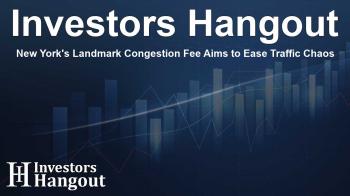New York's Landmark Congestion Fee Aims to Ease Traffic Chaos

New York City Introduces a Unique Congestion Fee
In a groundbreaking move, New York City has introduced a $9 congestion fee for vehicles entering Manhattan, a pioneering approach in the United States. This initiative aims to raise substantial funds for public transportation and significantly reduce traffic congestion within the bustling city.
Details of the Congestion Charge
The congestion fee came into effect recently, marking a significant shift in how urban traffic is managed. The charge applies predominantly to passenger vehicles navigating south of 60th Street in Manhattan during peak daylight hours, while trucks and buses face a higher fee of up to $21.60. Interestingly, the fee sees a considerable reduction of 75% during the nighttime hours.
Feasibility and Implementation
To streamline the process, the charge is collected electronically through license plate readers, and private cars are billed once per day, regardless of the number of entries. Taxis and ride-share services, such as Uber (NYSE: UBER) and Lyft (NASDAQ: LYFT), face a fee of 75 cents and $1.50 per trip, respectively. This method has sparked discussions about how technological advancements can facilitate modern traffic management.
Learning from Global Examples
While New York stands as the first U.S. city to adopt such a toll, other major cities, such as London, have paved the way since implementing their similar scheme in 2003. This approach has raised valuable lessons; initial resistance usually gives way to acceptance as citizens begin to notice the benefits of reduced traffic and improved public transportation services.
Expected Outcomes
Experts like Sarah Kaufman from NYU's Rudin Center for Transportation anticipate a gradual shift in public perception regarding the congestion fee. As the dust settles, the hope is that residents will appreciate the decreased congestion and enhanced transit options, leading to a better overall commuting experience.
Impact on Traffic and Public Transit
New York's Metropolitan Transportation Authority forecasts that the congestion fee will result in approximately 80,000 fewer cars entering the city per day - a notable 11% reduction in daily traffic. Currently, over 700,000 vehicles pass into Manhattan's central business district, clogging the streets and leading to an average speed of just around 7 mph (11 kph). This figure represents a dramatic 23% decline in travel speed since 2010, underscoring the need for immediate action.
Economic Implications
In terms of financial projections, the city estimates that the congestion charge could generate as much as $500 million in its first year. New York Governor Kathy Hochul highlighted that this revenue will play a crucial role in supporting $15 billion in debt financing aimed at upgrading subway systems, buses, and other public transit infrastructures.
Conclusion
The introduction of the congestion fee in New York City represents a forward-thinking approach to urban traffic management. While challenges may arise in terms of public acceptance, the potential benefits for commuters and the environment cannot be underestimated. As more cities look to apply similar strategies, New York will certainly be paving the way for future urban planning endeavors.
Frequently Asked Questions
What is the purpose of the $9 congestion fee in New York City?
The congestion fee aims to reduce traffic congestion in Manhattan while generating funds for mass transit improvements.
How does the fee affect different types of vehicles?
Passenger vehicles are charged $9, while trucks and buses face fees of up to $21.60, with lower rates at night.
What technology is used to implement this fee?
The fee is collected electronically using license plate readers installed throughout the designated areas.
What economic benefits is New York City expecting from this fee?
City officials estimate the fee will generate about $500 million in its first year, funding significant transit improvements.
How does this fee compare to congestion charges in other cities?
New York is the first U.S. city to adopt such a fee, following cities like London, which implemented a similar charge in 2003.
About Investors Hangout
Investors Hangout is a leading online stock forum for financial discussion and learning, offering a wide range of free tools and resources. It draws in traders of all levels, who exchange market knowledge, investigate trading tactics, and keep an eye on industry developments in real time. Featuring financial articles, stock message boards, quotes, charts, company profiles, and live news updates. Through cooperative learning and a wealth of informational resources, it helps users from novices creating their first portfolios to experts honing their techniques. Join Investors Hangout today: https://investorshangout.com/
Disclaimer: The content of this article is solely for general informational purposes only; it does not represent legal, financial, or investment advice. Investors Hangout does not offer financial advice; the author is not a licensed financial advisor. Consult a qualified advisor before making any financial or investment decisions based on this article. The author's interpretation of publicly available data presented here; as a result, they should not be taken as advice to purchase, sell, or hold any securities mentioned or any other investments. If any of the material offered here is inaccurate, please contact us for corrections.
